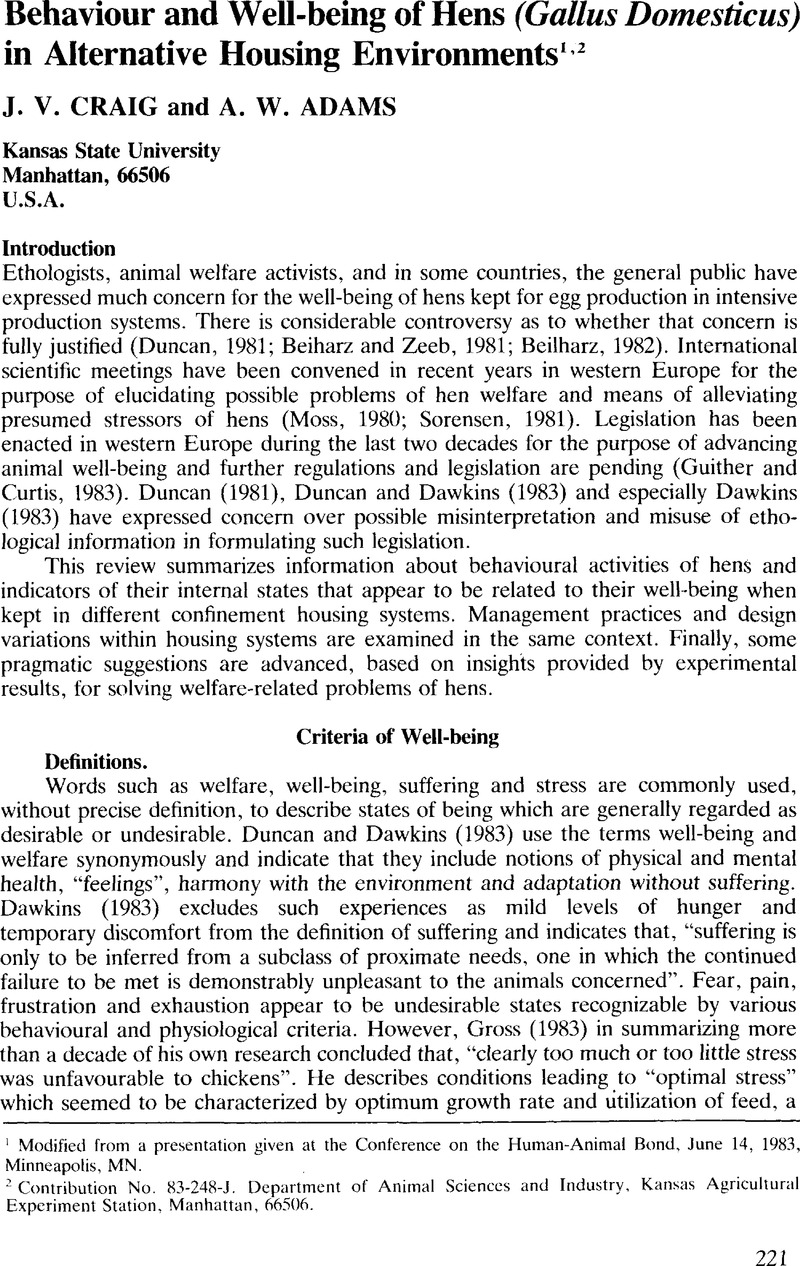Crossref Citations
This article has been cited by the following publications. This list is generated based on data provided by Crossref.
CRAIG, J.V.
and
CRAIG, J.A.
1985.
Corticosteroid Levels in White Leghorn Hens as Affected by Handling, Laying-House Environment, and Genetic Stock.
Poultry Science,
Vol. 64,
Issue. 5,
p.
809.
Jones, R. B.
1985.
Fearfulness of hens caged individually or in groups in different tiers of a battery and the effects of translocation between tiers.
British Poultry Science,
Vol. 26,
Issue. 3,
p.
399.
Nicol, C.J.
1986.
Non-exclusive spatial preference in the laying hen.
Applied Animal Behaviour Science,
Vol. 15,
Issue. 4,
p.
337.
CRAIG, J.V.
CRAIG, J.A.
and
VARGAS, J. VARGAS
1986.
Corticosteroids and Other Indicators of Hens’ Well-Being in Four Laying-House Environments.
Poultry Science,
Vol. 65,
Issue. 5,
p.
856.
KOELKEBECK, K.W.
AMOSS, M.S.
and
CAIN, J.R.
1987.
Production, Physiological, and Behavioral Responses of Laying Hens in Different Management Environments.
Poultry Science,
Vol. 66,
Issue. 3,
p.
397.
OKPOKHO, N.A.
CRAIG, J.V.
and
MILLIKEN, G.A.
1987.
Density and Group Size Effects on Caged Hens of Two Genetic Stocks Differing in Escape and Avoidance Behavior ,.
Poultry Science,
Vol. 66,
Issue. 12,
p.
1905.
Jones, R. B.
1987.
Assessment of fear in adult laying hens: Correlational analysis of methods and measures.
British Poultry Science,
Vol. 28,
Issue. 2,
p.
319.
Cunningham, D.L.
van Tienhoven, A.
and
De Goeijen, F.
1987.
Dominance rank and cage density effects on performance traits, feeding activity and plasma corticosterone levels of laying hens (Gallus domesticus).
Applied Animal Behaviour Science,
Vol. 17,
Issue. 1-2,
p.
139.
McGlone, John J.
and
Blecha, Frank
1987.
An examination of behavioral, immunological and productive traits in four management systems for sows and piglets.
Applied Animal Behaviour Science,
Vol. 18,
Issue. 3-4,
p.
269.
Bryan Jones, R.
1987.
Fearfulness of caged laying hens: The effects of cage level and type of roofing.
Applied Animal Behaviour Science,
Vol. 17,
Issue. 1-2,
p.
171.
Curtis, Stanley E.
1987.
Animal Well-Being and Animal Care.
Veterinary Clinics of North America: Food Animal Practice,
Vol. 3,
Issue. 2,
p.
369.
Craig, J.V.
Okpokho, N.A.
and
Milliken, G.A.
1988.
Floor- and cage-rearing effects on pullets' initial adaptation to multiple-hen cages.
Applied Animal Behaviour Science,
Vol. 20,
Issue. 3-4,
p.
319.
Ramos, N.C.
and
Craig, J.V.
1988.
Pre-laying behavior of hens kept in single- or multiple-hen cages.
Applied Animal Behaviour Science,
Vol. 19,
Issue. 3-4,
p.
305.
BARTOV, I.
BORNSTEIN, S.
LEV, Y.
PINES, M.
and
ROSENBERG, J.
1988.
Feed Restriction in Broiler Breeder Pullets: Skip-a-Day Versus Skip-Two-Days.
Poultry Science,
Vol. 67,
Issue. 5,
p.
809.
Jones, R.Bryan
1988.
Repeatability of fear ranks among adult laying hens.
Applied Animal Behaviour Science,
Vol. 19,
Issue. 3-4,
p.
297.
Dawkins, Marian Stamp
1988.
Behavioural deprivation: A central problem in animal welfare.
Applied Animal Behaviour Science,
Vol. 20,
Issue. 3-4,
p.
209.
Parkhurst, Carmen R.
and
Mountney, George J.
1988.
Poultry Meat and Egg Production.
p.
85.
CUNNINGHAM, D.L.
van TIENHOVEN, A.
and
GVARYAHU, G.
1988.
Population Size, Cage Area, and Dominance Rank Effects on Productivity and Well-Being of Laying Hens.
Poultry Science,
Vol. 67,
Issue. 3,
p.
399.
O’KEEFE, T.R.
GRAVES, H.B.
and
SIEGEL, H.S.
1988.
Social Organization in Caged Layers: The Peck Order Revisited.
Poultry Science,
Vol. 67,
Issue. 7,
p.
1008.
Roush, W.B.
Bock, R.G.
and
Marszalek, M.A.
1989.
Evaluation of crowding of caged laying hens (Gallus domesticus) using fuzzy set decision analysis.
Applied Animal Behaviour Science,
Vol. 23,
Issue. 1-2,
p.
155.





